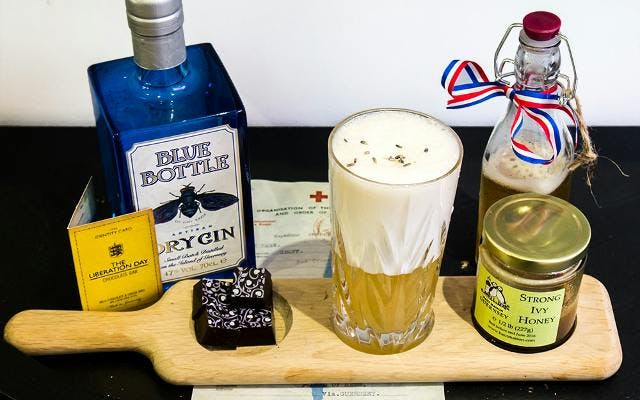
Cocktail of the Week: Blue Bottle Gin's Victouaire Gin Fizz
Our Club Members are loving their Blue Bottle Gin this October - but we've completely sold out of both! To get all of the amazing gins we feature delivered to your door along with GINNED! Magazine and the surprises included in every box, become a Craft Gin Club Member! Join today with the code GINSECT10 and get £10 off your first gin box!
Below is an excerpt from the October 2015 edition of GINNED! Magazine about Blue Bottle Gin from Guernsey. Every month, Craft Gin Club Members receive a bottle of amazing small-batch gins and gin complements accompanied by GINNED! Magazine which is full of information about the gin, the distillery and loads of fascinating features.
For the better part of our existence, we humans have celebrated victories with a communal drink, a toast raised partially in commemoration of the courageous conquered, but primarily elevated for the valiant victors. The Victouaire Gin Fizz is just such a drink, created by Guernsey’s ballyhooed barman, James Le Gallez - who enjoys working with his native island’s Blue Bottle Gin - for the 70th anniversary of Liberation Day, an event that coincides with the end of World War II and one glorified in Guernsey as the Channel Islands were the only part of British soil occupied during the War.
For nearly five years Nazi Germany occupied the Channel Islands, from around the period of its successful invasion of France in June 1940 to the day after VE Day, May 9th, 1945, when British forces landed on Guernsey to surrendering Germans. The story of why Guernsey and Jersey were left to takeover is one of tactics - it was decided by British forces that he islands were of little strategic importance to the overall war effort and were thusly demilitarised, allowing the Germans to essentially dock their boats and gain immediate control.
The demilitarisation was kept quiet, allowing for the evacuation of those who sought it. Approximately 40% of the 42,000 inhabitants of Guernsey opted to board one of the boats bound for England and Scotland over a four day period a little over one week before the June 30th arrival of the Germans. More would have fled if it had not been for the lack of evacuation resources and the Guernsey government had to convince those that stayed behind that it was for the best. Comparatively, only 13% of the 50,000 residents of Jersey sailed to the mainland before the Nazis arrived.
Unlike Westminster, Hitler decided that the islands were of strategic significance and set about transforming them into highly fortified bastions as part of his Atlantic Wall, a system of fortifications built by the Nazi’s along the coasts of occupied territory spanning from Southern France, through the Lowlands, up the Western coast of Denmark and continuing upwards into Norway. Of the resources dedicated to constructing the Wall, Hitler dedicated over 10% of all of the reserved steel and concrete for the Channel Islands which resulted in intricate tunnel systems for storage and protection of arms and provisions as well as numerous gun turrets and barricades that dot the Guernsey and Jersey coastlines to this day.
Of course, all of this construction required labourious hands to build the fortifications and despite attempts to use Channel Islanders to do so, the Hague Conventions of 1899 and 1907 prohibited occupying armies from forcing the occupied to aid in military operations. So the Nazis needed to import labour. In total, they brought about 16,000 people that ranged from those compensated from their work from occupied France and the Benelux countries to immigrants to France from the Maghreb given to the Germans by the French Vichy government to slave labour imported from the Soviet Union.
On the island of Aldernay, part of the Bailiwick of Guernsey and the most northern of the Channel Islands, the Nazis set up four concentration camps to house the forced labourers. 6,000 prisoners were kept on Aldernay including the aforementioned people from Soviet Eastern Europe, Spaniards taking refuge in France after the Spanish Civil War, and the people most associated with Nazi concentration camps, Jews. 700 of the prisoners are thought to have succumbed to a combination of the excruciating work, harsh weather and the brutality of their Nazi overseers. Despite records of human rights abuses and murder, no occupying German was ever prosecuted.
In the grand scheme of World War II, these stories of life in concentration camps are not surprising. What makes them different is that they were built and atrocities carried out on British soil, a fact that makes Guernsey Liberation Day all the more symbolic, a day that will continue to be celebrated annually with a Victouaire Gin Fizz.
Victouaire Gin Fizz
50ml Blue Bottle Gin
25ml Fresh Lemon Juice
25ml Vanilla, Lavender & Ivy Honey Syrup
3 Drops of Orange Flower Water
1 Egg White
Soda Water
Combine first five ingredients in a cocktail shaker, shake without ice then shake again with ice. Pour into a long glass (without ice) and top with soda water.Garnish with a sprinkle of dried lavender and serve with vanilla chocolates







